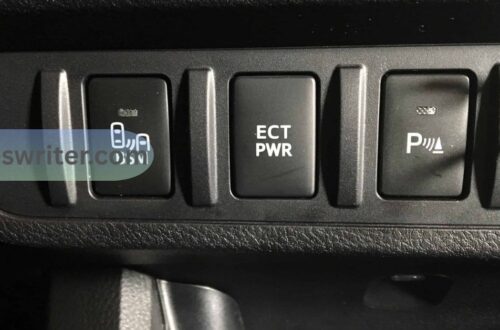A goodwill fix (or goodwill repair) is a courtesy repair by Toyota when a vehicle’s warranty has just ended. In other words, Toyota helps cover a repair even though the official warranty is expired. This is not guaranteed by law – it’s done on Toyota’s goodwill – but it can save an out-of-warranty owner thousands of dollars.
Goodwill repairs matter, especially if a major component fails soon after the coverage ends. For example, some owners have faced engine or transmission failures just past the warranty mileage.
In one Canadian case, a 2021 Toyota Highlander with 121,000 km had its transmission fail shortly after the warranty expired. Toyota Canada refused a goodwill repair, leaving the owner responsible for a $12,000 bill.
On the other hand, Toyota will often handle more minor out-of-warranty fixes. For instance, industry reports note that a simple fix – such as replacing a window switch that fails a month past the warranty – will typically be done by the dealer (Toyota allows dealer repairs up to approximately $1,000 as a courtesy). This article explains who may qualify for a goodwill adjustment in Canada, how the request process works, and how to increase your chances of receiving one.
Who Qualifies for Goodwill Repairs in Canada:
Toyota considers several factors when deciding on whether to perform goodwill repairs. A key factor is brand loyalty and service history. Toyota itself notes that “a long history of brand loyalty can determine how generously an automaker is willing to cover extra repairs.”
In practice, this means that original owners who have regularly serviced their Toyota at authorized dealers have a better chance. Dealers and Toyota representatives will review maintenance records, including oil changes and inspections, performed by Toyota or Lexus technicians. Low mileage, relative to the vehicle’s age, also helps. Being a current or past Toyota owner (with multiple Toyotas owned) can make the dealer more inclined to assist.
Other important factors include the extent to which the repair falls outside the warranty and the nature of the problem. A breakdown that occurs only slightly beyond the warranty (for example, a few days or a hundred kilometers past the limit) may receive more sympathy than one that occurs years later.
Additionally, Toyota is more likely to consider goodwill if the issue is a manufacturing or design defect, such as a known engine or transmission fault, rather than wear and tear or owner misuse. For example, if your oil consumption suddenly increases well past the warranty, dealers may feel it was avoidable and refuse to fix it.
Generally, if you have complete dealer service records and are loyal to Toyota, with no long gaps of neglect or outside-shop repairs, you stand a better chance. By contrast, if your car was mainly serviced at a quick oil lube or you have missing receipts, Toyota may view that as a strike against your claim.
Real Examples and Common Toyota Issues:

People report goodwill fixes (or denials) on many Toyota models. Common problems just outside warranty include:
1. Engine failures (timing-chain issues, oil burning, etc.):
Some owners of 2010s Camrys, Avalons, or Tacomas have experienced engine problems shortly after reaching 60,000 km. In a few cases, dealers agreed to a goodwill fix or partial credit, but many did not.
2. Transmission failures:
For example, some 2020 and later RAV4s, Highlanders, and C-HRs have experienced transmission faults. In one case, a 2021 Highlander (123,000 km) experienced transmission failure shortly after its powertrain warranty expired. The owner reported, “They won’t do a goodwill warranty for it, and we are on the hook for $ 12,000!”
3. Electrical or accessory issues:
Problems such as faulty door switches, window motors, or ECM (Engine Control Module) failures may occur. These tend to be cheaper fixes. As Toyota acknowledged, a repair like replacing a window switch, which fails a month after the warranty, would cost only a few hundred dollars – dealers can cover such repairs up to about $1,000 out-of-pocket.
4. Moonroof or sunroof leaks:
Some owners report leaks or mechanical failures in roof systems (RAV4, Prius, etc.). These can be expensive to fix. Toyota will consider goodwill if it appears to be a design defect; however, documentation is key.
5. Other failures:
Air conditioning compressor failures, fuel pump issues, electronic module failures, and steering components have also prompted goodwill requests.
Each case varies. Some owners receive partial assistance (such as Toyota covering half the cost), but many are outright refused. Success often depends on timing and documentation.
Also Read: Toyota Prius Warning Lights Guide-Complete Guide for Owners
How the Goodwill Request Process Works:
To ask for a goodwill repair, follow these steps:
Step 1:
Visit your local Toyota dealership. Inform the service advisor or technician about the problem and explain that it occurred just after the warranty period.
Step 2:
Ask for goodwill assistance. Explain that you have been a loyal Toyota customer (if valid) and show your maintenance records. Be polite and clear. Say something like: “This problem started right after my warranty ended – could Toyota help as a goodwill gesture?”
Step 3:
Provide documentation. Provide the dealer with your original sales invoice (proof of purchase date) and service records, including all receipts from the dealer. Also, provide any manufacturer recalls or service bulletins that relate to your issue. If you have an extended warranty, please also show that contract (it may cover some of the costs).
Step 4:
Dealer evaluates and escalates. The service manager will review the case and can often perform minor repairs directly (Toyota allows dealers to fix up to about $1,000 without consulting corporate). For larger repairs, the dealer will contact their District Service Representative or the Toyota regional office for approval.
Step 5:
Decision by Toyota reps. Ultimately, Toyota’sToyota’s district or regional reps (field service managers) decide. In Toyota’s system, district representatives “have the final say” on goodwill claims, and any claim exceeding $10,000 is manually reviewed. They may approve, deny, or offer partial assistance.
Step 6:
Follow up. Be patient. Large claims may require weeks of back-and-forth. It’s okay to ask for updates politely. If the dealer can’t help after a month or so, you may escalate the issue to Toyota Canada directly.
At any point, you can contact Toyota Canada Customer Service for advice. Toyota Canada’s head office, located in Toronto, can be reached at 1-888-869-6828 (Monday to Friday, 8:00 am–6:00 pm ET). You can explain your situation and ask if there is any record of your dealer’s goodwill inquiry. Contacting Toyota Canada may be helpful if the dealer appears to be stuck. (Toyota Canada Inc. is the national distributor and covers all provinces, so this number works anywhere in Canada.)
Canadian Context: Toyota Canada and Dealerships:
Toyota Canada operates separately from Toyota in the USA. All goodwill decisions for Canadian cars are made by Toyota Canada Inc., headquartered in Ontario, and its regional managers. Each province is served by Toyota dealerships, which report to regional or district managers.
The dealership is your first point of contact. The local dealer’s Service Manager gathers your information and sends a request up the chain. Behind the scenes, Toyota has field reps called District Service Managers or District Service Representatives who handle warranty and goodwill cases. These reps have the authority to approve repairs or consult Toyota Canada’s head office for costly cases.
In practice, if your claim is straightforward and under approximately $1,000, the dealer can often approve it immediately. For bigger items, the dealer must submit a case to Toyota Canada. Then Toyota Canada’sCanada’s service reps and managers review it. The Ward’sWard’s Auto industry report confirms that Toyota’s field reps “have the final say” on goodwill and that dealers can self-fix minor repairs.
Note: Toyota USA in Texas or California does not handle Canadian cars. Always use Toyota Canada contacts. If you are speaking with a dealer in Canada, Toyota Canada’sCanada’s policies apply.
How Decisions Are Made:
When you submit a goodwill request, Toyota Canada considers several factors. According to Toyota’s service managers, brand loyalty and customer history are important factors. They also consider the cost of repair and the car’s importance to you (e.g., a daily driver vs. a secondary vehicle).
Toyota’s internal system allows field representatives to view all your information, including purchase history, service history, and photos of the damage, among other details. If the repair is minor (hundreds of dollars), they usually approve it. If the claim is large (thousands of dollars), it’s reviewed more closely and may require higher approval. As mentioned, any claim over $10,000 gets special attention.
In short, the local Service Manager starts the process and may handle minor fixes directly. For more expensive repairs, the case is referred to a District Service Representative or Toyota Canada’s warranty team. That team has the authority to grant or deny goodwill, and Toyota Canada’s customer experience center can get involved in challenging cases. Always remember that the decision is not final until Toyota’s representatives confirm it.
Also Read: How to Automatically Relearn TPMS on 2020 Toyota Supra-Ultimate Owner’s Manual
Common Reasons Goodwill Is Denied:
Goodwill is discretionary. Toyota will often deny a request if it finds any of the following red flags:
1. Non-dealer maintenance:
If your car was mainly serviced outside the Toyota/Lexus dealer network, the dealer may view it as a lack of official records. Toyota often expects owner loyalty, and using an independent shop can hurt your case.
2. Missing or incomplete records:
A lack of proof of regular oil changes or service or gaps in the records is a common reason for denial. Toyota may assume neglect or poor maintenance.
3. Too far out of warranty:
If the failure occurs long after the warranty (e.g., 150,000 km on a 10-year-old car with a 3-year/100,000 km powertrain warranty), goodwill is unlikely. The closer you are to warranty limits, the better.
4. Used or modified vehicle:
If you bought the car used (with an unknown history) or have aftermarket modifications, Toyota may refuse to accept it. They generally treat the car as out of warranty in those cases.
5. Previous claim or incident:
If Toyota Canada has already denied the issue before, they are unlikely to reverse their decision. Additionally, if the same problem occurred earlier and was covered by warranty or goodwill, a subsequent fix might be denied.
6. Maintenance-related damage:
If Toyota determines that the issue was caused by improper maintenance (e.g., skipped oil changes, incorrect oil, or not tightening parts properly), they will deny goodwill. Toyota expects basic upkeep.
In summary, to avoid denial, keep all your dealer-maintenance records up to date, follow Toyota’s recommended service schedule, and retain receipts.
Tips to Improve Your Chances At Goodwill Toyota:

Here are some helpful tips for a better outcome:
1. Stay calm and polite:
Always be courteous to the dealer staff and Toyota reps. Getting angry or threatening legal action usually backfires, causing more harm than good.
2. Gather paperwork:
Please bring your original sales invoice, all service receipts, warranty booklet, and any extension or warranty agreements. Organized records show you’ve-you’ve cared for the car.
3. Highlight loyalty:
Mention if you’ve owned multiple Toyotas or have done all (or most) of your service at Toyota dealers. A friendly relationship with your dealer manager can also help.
4. Explain clearly:
Describe the problem timeline: when it started, how you noticed it, and that it occurred just after the warranty ended. If you notice any warning signs (such as unusual noises or lights), please report them.
5. Ask about TSBs or recalls:
If your problem sounds like a known issue, politely ask if Toyota has a Technical Service Bulletin (TSB) or recall for it. (If a recall or TSB covers it, it’s usually fixed-free, even out of warranty.)
6. Be flexible on costs:
Sometimes, offering to split costs (like asking Toyota to pay half) can lead to a compromise. If the dealer provides a goodwill contribution (e.g., 50%), it may be better than nothing.
7. Get help if needed:
If you feel stuck, ask to speak to the dealership’s District Manager or contact Toyota Canada’s customer service at 1-888-869-6828. You can also seek advice on Canadian Toyota owner forums (e.g., RFD or Reddit) to see what others have done.
Remember: goodwill is a courtesy, so patience and persistence help. If you handle the situation professionally, you’re more likely to get a sympathetic hearing.
Glossary:
1. Powertrain:
The main parts of a vehicle that produce power and move the car (the engine, transmission, drive shafts, and related parts). For Toyota Goodwill, a “powertrain warranty” typically refers to coverage for the engine and transmission.
2. ECM (Engine Control Module):
The computer module that controls engine functions like fuel injection and ignition. If your “check engine issues are due to a faulty ECM after the warranty has expired, you may be eligible for a goodwill replacement.
3. District Manager (DM):
A Toyota corporate representative in a region (often oversees multiple dealerships). In Canada, a DM may be involved if you escalate beyond the local dealer. The DM works with Toyota Canada to resolve service issues.
4. TSB (Technical Service Bulletin):
An official document from Toyota that describes how to fix a known vehicle problem. TSBs are not recalls (they’re not mandatory fixes), but being aware of one can support your case.
Frequently Asked Questions:
Q1. Can I get a goodwill fix if I serviced my car at an independent shop?
It’s harder if you don’t use Toyota dealers. Toyota trusts its dealer records. You can still try, but missing dealer receipts will weaken your case. Provide whatever records you have and focus on how well you maintained the car. Generally, providing service at the dealer increases your chances of receiving goodwill assistance.
Q2. Who approves a Toyota goodwill repair in Canada?
Toyota Canada ultimately makes the call. Usually, your dealer’sdealer’s Service Manager will first evaluate it. If they need help, they contact their Toyota district service representative. That rep or Toyota Canada’s customer service center will approve or deny the request. Toyota notes that their field reps “have the final say” on goodwill claims. In other words, Toyota Canada’s team – not the local dealer alone – has the authority to grant it. You may also contact Toyota Canada at 888-869-6828 for guidance.
Q3. Does Toyota Canada offer goodwill repairs in all provinces and territories?
Yes. Toyota Canada is a national company, so any Toyota owner in Canada can request goodwill through their nearest authorized dealer. There’s no province where it’s unavailable. The same program and criteria apply coast-to-coast, from British Columbia to Newfoundland.
Q4. How long does a goodwill claim take?
There is no fixed timeline. Minor fixes might be handled in a few days at the dealer. Larger repairs often take weeks. Dealers can quickly resolve minor issues ranging from $500 to $1,000. If Toyota Canada needs to review an item, expect at least a few weeks, possibly longer, for those that are costly. Owners report cases taking 4–6 weeks or more, with back-and-forth delays. Be prepared to wait and check in politely for updates.
Q5. What if my goodwill request is denied? Can I appeal?
Toyota’s goodwill decision is usually final. There isn’t a formal appeal board. However, if you are denied, you can calmly ask why and if any additional information might change it. Sometimes, getting a second opinion from another Toyota representative (e.g., a regional manager) can be helpful.
You may contact Toyota Canada Customer Service to re-explain your case. In rare cases, owners have gone to consumer protection agencies or local news outlets for help – but that’s a last resort. The best approach is to present all facts and then accept the answer if they still decline.
Conclusion:
While a goodwill repair from Toyota Canada isn’t guaranteed, it remains a viable option for owners who experience problems just outside the warranty period—especially for loyal customers with strong maintenance records.
The process depends heavily on your relationship with the dealership, your service history, and the extent to which the issue falls beyond warranty coverage. By understanding how goodwill requests work, preparing your documents, and approaching the dealer respectfully, you can increase your chances of receiving assistance.
In the end, even if the repair isn’t fully covered, Toyota may offer partial support, saving you significant costs. For Canadian Toyota owners facing unexpected repairs, pursuing a goodwill fix is almost always worth the effort.



